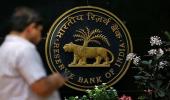'There are occasions when the prices of individual items like food raise inflation; then supply-side measures must be taken.'
'But if there is continued inflation, it means liquidity is aggravating the situation.'

Inflation is a subject that can drive dry central bankers to become droll.
'As is often the case, we are navigating by the stars under cloudy skies,' said Jerome Powell, the United States Federal Reserve Chair, on August 25, suggesting interest rates could increase further.
It is also a subject that can see different approaches.
On the day Powell became poetic, Indian Finance Minister Nirmala Sitharaman said inflation was critical to economic growth, but an over-reliance on interest rates, without managing the supply side, would not be a complete solution.
True to her word, Sitharaman and others in the government have been taking measures to improve the availability and affordability of goods in India.
The most recent step is the cut in the prices of liquefied petroleum gas cylinders.
Even then, retail inflation is expected to overshoot the monetary policy committee's projection of 6.2 per cent, which was scaled up from the earlier 5.2 per cent for the second quarter of the current financial year.
The food-led overall retail inflation rate rose to 7.44 per cent in July from 4.87 per cent in the previous month and is expected to remain high in the coming few months.
Of the 2.57 percentage point jump in the overall inflation in July over the previous month, 1.34 percentage points, or half of the jump, was from tomato, although it has only 0.57 per cent weight in the consumer price index (CPI).
On the other hand, the Reserve Bank of India maintained the status quo in its policy rate for a third time in a row in August.
It raised the cash reserve ratio (CRR) for incremental deposits between May 19 to July 28 for the fortnight beginning August 12 to suck out excess liquidity in the banking network caused by the return of the Rs 2,000 currency notes.
Former RBI governor Dr C Rangarajan says the headline inflation does not depend only on the availability of goods and services but also on liquidity.
Asked whether the RBI should raise the policy rate at some point, he explains that this is not a question of increasing the rate but about controlling liquidity.
"There are occasions when the prices of individual items like food raise inflation; then supply-side measures must be taken. But if there is continued inflation, it means liquidity is aggravating the situation," he points out.
If that is the case, measures to control liquidity have to be taken, which may include open-market operations, besides interest rates, he says, adding cash reserve ratio is not a preferred route.
The price pressure in some food and fuel items and the emergence of new ones triggered a debate among policymakers about the route they should take to tame surging prices.
In this context, the finance minister's statement about interest rates is being seen as a kind of guidance.
However, current RBI Governor Shaktikanta Das indicated that the policy rate might need to rise if food inflation became generalised.
Food inflation, led by tomatoes, rose to 11.5 per cent in July from 4.5 per cent in the previous month.
New price pressure points are cropping up, forcing the government to announce specific measures.
However, retail inflation in wheat and rice did not drop into single digits, prompting the government to announce new measures (see: Supply-Side Steps).
Tomato prices surged due to their low production caused by the unusual heat in March and April, forcing the National Agricultural Cooperative Marketing Federation of India (Nafed) and the National Cooperative Consumers' Federation (NCCF) of India to sell them at subsidised rates.
Now that tomato prices have abated, onions have turned expensive due to the delayed monsoon in Maharashtra and Karnataka and the high moisture content in the stored rabi crops due to unseasonal rains in April in these states.
The government imposed a 40 per cent duty on onion exports. This infuriated farmers, who staged protests in parts of Maharashtra.
Major wholesale markets in the state suspended the auctions of the kitchen staple for a time.
Indeed, it is not easy to balance the objectives of providing commodities at affordable prices to consumers and ensuring remunerative rates to farmers.
Now chana pulses (gram) are showing a jump in prices, while jeera (cumin) has continuously witnessed high inflation in the current financial year.
The policy response to food inflation will be guided by the nature of this price pressure since core inflation -- inflation in non-food, non-fuel items -- is now on a downward trajectory.
Dr Rangarajan clarifies that liquidity does not mean only discounted money available to banks, but also reserve money.
The banking system liquidity was in a deficit for the first time since March-end after the RBI took the incremental CRR step, and due to advance tax outflows.
Reserve money includes all the money in circulation as well as bank deposits.
Anil K Sood, professor and co-founder at the Institute of Advanced Studies in Complex Choices, says the RBI does not have a direct role in bringing down food prices, but has the unenviable task of managing inflation as well as inflation expectations.
"It must curtail the availability of credit for speculative investment in commodities and commodity derivatives market; it must also not provide a free lunch in the form of an artificially lower cost of credit," he says.
Sood believes the central bank should consider raising the rate by 0.25 per cent at the earliest, though not this financial year.
He disagrees that food inflation is a transitory phenomenon, as some would have us believe.
To buttress his point, he says the average retail food inflation rate has been about 5.3 per cent between 2014 and 2022.
If one excludes the years 2017 and 2018, the average food inflation was 6.3 per cent during this period.
Madan Sabnavis, chief economist at Bank of Baroda, says one cannot bring down inflation. At most, one can control it when there are shortfalls in supplies.
"Hence, what the RBI is doing is to control inflation on the demand side by rolling up the repo rate to 6.5 per cent," he points out.
One has to remember, says Sabnavis, that there are limits to which any government or central bank can control inflation.
But no one can stop them from being droll.
May 2022:
- Wheat exports banned
September 2022:
- 20% export duty on non-basmati rice
- Ban on exports of broken rice
June 2023:
- Stock limits on tur for wholesalers, retailers, big chain retailers, millers and importers
July 2023:
- After 15 years, stock limits imposed on wheat for traders, wholesalers, retailers, big chain retailers and processors
- Non-basmati exports banned
- Exports of de-oiled rice bran banned
- Nafed, NCCF start selling subsidised tomatoes
August 2023:
- 20% duty on exports of parboiled rice
- Tomato imports from Nepal begin
- 40% duty on onion exports
- Rs 200 price cut per LPG cylinder for domestic use
September 2023:
- Prices slashed by Rs 158 per commercial LPG cylinder weighing 19 kg
- Imports of LPG, liquefied propane and liquefied butane exempt from 15% agriculture cess
Feature Presentation: Aslam Hunani/Rediff.com











